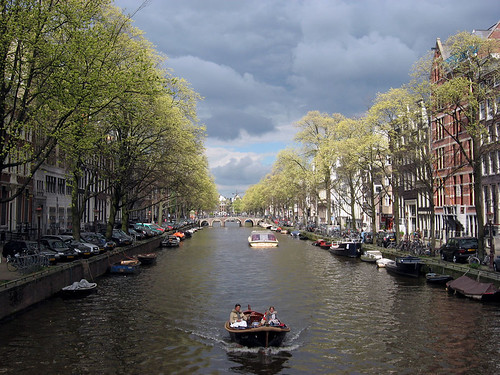
Lively, lascivious Amsterdam has a unique atmosphere that belies the caricature of the dour Dutch.Radiating out from the Dam Square, the historic centre of the city is ringed by quaint canals and cobbled streets, thronged with bicycles, tourists, houseboats, students, and street performers. The city wears two faces: on one it smiles and beckons hedonistic youth with its notorious Red Light District and liberal view of marijuana use, while on the other it offers some of Europe's finest museums and art galleries.For the tourist the joy of Amsterdam is its compactness. The old part of town is a pleasure to explore on foot, strolling across ancient bridges and down narrow lanes past gabled houses, dropping in to browse in inviting souvenir boutiques crammed with blue and white Delft china and wooden clogs. Pavement cafes and cosy bars offer rest and refreshment. An alternative is to take a circular canal-boat cruise and see the city from the water, peering in on the lives of the locals who live on houseboats lining the waterways.At night even the most conservative visitor is drawn by the lively atmosphere of the infamous Red Light District, known as De Wallen, which is bounded by the Oudezijds Voorburgwal and Oudeziujds Achterburgwal canals near the Dam Square. Here prostitutes display their charms in brightly lit shop windows and touts encourage passers-by to view raunchy floorshows. The best nightclubs, bars, and the theatres and cinemas are mainly to be found in the bustling Leidesplein and Rembrandtplein.
Anne Frank House

This museum is dedicated to the memory of Anne Frank whose famous diary, recorded over a two-year period, describes the experiences of a Jewish teenager during World War II. Part of the house was used as a hiding place by the Franks and others to escape Nazi persecution. The families were later discovered and sent to their deaths in the concentration camps. Otto Frank was the only survivor. The original diary is on display as part of the permanent exhibition. The museum also hosts temporary exhibits that focus on related issues.
Van Gogh Museum

The Van Gogh Museum is a definitive attraction in Amsterdam. Situated in a modern building, the simple architecture subtly underscores the artists' colourful and extraordinary work. The museum houses a permanent display of several hundred of Van Gogh's paintings and drawings, many of which will be familiar even to the untrained eye. The collection is organised according to three criteria. The first of these is the work of the artist, which is divided into five notable periods. Then there is the display of work of other artists including those of his friends and contemporaries. The third section is the showcase of the museum's history recording its progress with a feature on the development of the new wing designed by Japanese architect, Kisho Kurokawa, built to house the temporary exhibitions.
Red Light District (De Wallen)

A visit to Amsterdam would not be complete without a stroll around the notorious Red Light District. The atmosphere can be chaotic with throngs of tourists jostling for space alongside city slickers, pimps and drug dealers. The prostitutes of De Wallen are part of a legal and regulated industry that includes compulsory health checks and taxable income. Prostitution is by no means the only attraction of the area. The district's architecture comprises a scenic mix that dates back to the Middle Ages. Areas to explore include Waterlooplein, Zeedijk and Nieuwmarkt Square. Waterlooplein is the location of the modern City Hall and Muziek Theatre. The square was created in 1880 from two canals that were filled and then allocated to Jewish traders who used to ply their wares on its pavements. Nieuwmarkt Square was also once home to a thriving Jewish community, mainly Portuguese Jews who had fled from persecution during the Spanish Inquisition. The cultural diversity of this area extends to Zeedijk Street, which is often referred to as Chinatown. The street runs from the Saint Olof Chapel to De Waag.
The Royal Palace (Koninklijk Paleis)
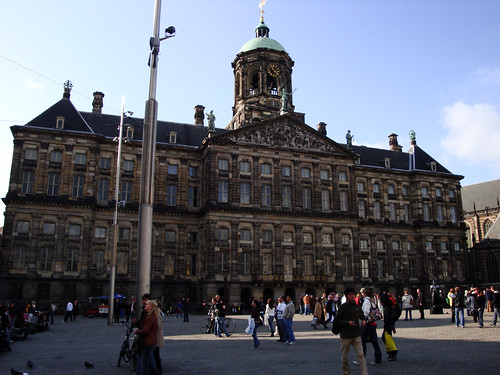
Although the Royal Palace is the official Royal residence it is mainly used for functions as the family reside in The Hague. The building dates back to 1648 and was originally designed for use as Amsterdam's city hall. King Louis Napoleon however had other plans. In 1808 he turned the city hall into a palace. A large collection of furniture from this period adorns its interiors. Guided tours are offered to visitors (these need to be booked two weeks in advance). The Royal Palace will be closed for renovations from 8 September 2005 until early 2009.
National Maritime Museum
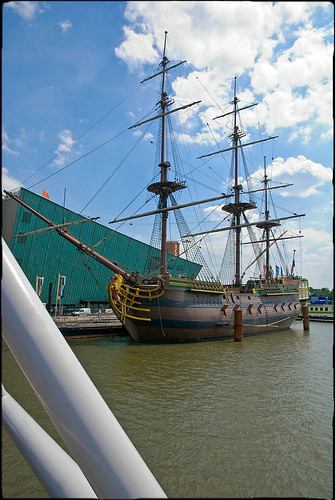
Covering four centuries of Dutch naval history, the National Maritime Museum allows visitors to glimpse into the adventurous seafaring past of Dutch explorers and merchants through exhibits of antiquarian maps, navigation instruments, paintings and ship models, creating one of the most extensive collections of maritime memorabilia in the world. A major attraction is the life-size reconstruction of a Dutch East India Company ship called the Amsterdam, which is docked behind the museum. Learn about dated maritime trade, naval combat, fishing and whaling and the intrepid journeys that took the Dutch fleet and her crew to remote destinations as far away as modern day Indonesia, India and South Africa. Please Note: The National Maritime Museum Amsterdam will be closed until 2010 for major renovations. The Dutch East Indiaman Amsterdam is currently moored at the NEMO Science Centre where it is open to the public.
Amsterdam Coffee Shops
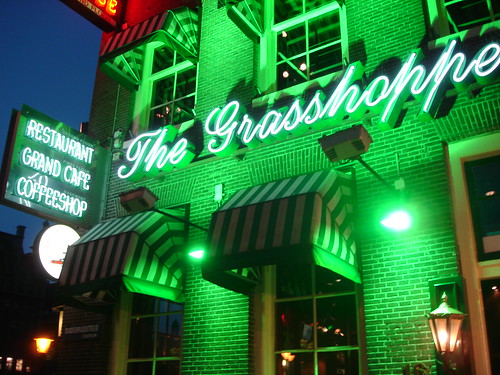
Amsterdam's coffee shops are an iconic part of the city and for many tourists they constitute a unique and essential part of any visit to the Netherlands.In Amsterdam, 'coffee shop' means a place where cannabis is openly sold and smoked, while 'café' refers to somewhere that sells coffees, tea and cakes. The coffee shops can legally sell up to 5 grams of marijuana to adults over 18 years of age. Travellers are warned, however, that the personal possession of drugs is illegal.There are a variety of coffee shops in the city, from laid-back and mellow to psychedelic and loud. It is expected of customers to consume not only the cannabis but also a beverage or snack while at the venue. Most coffee shops offer several kinds of weed or hash, listed on a 'menu', which the staff can give advice on. The prices vary according to the quality and be warned: the local skunk is very strong!
Maastricht
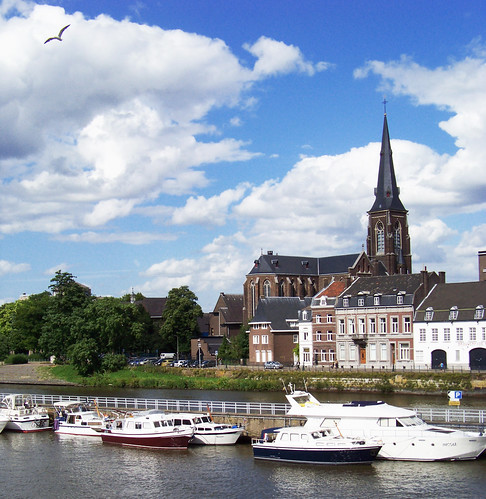
Maastricht is the oldest city in the Netherlands, peacefully perching on the banks of the Maas River. It is also one of the sunnier spots, located at Holland's southernmost point, squeezed in between the Belgium and German borders. Ancient fortifications provide pleasant walking routes and some of these can be explored on the city's western outskirts. The Bonnefantenmuseum traces the city's historical roots, and makes for a good introduction to one's visit. Another must-see is the Basilica of Saint Servatius. It is a medieval cruciform basilica with a significant collection of religious artefacts as well as the burial place of Holland's first bishop. In the old centre of Maastricht is a selection of shops and department stores. Here one can also savour the fine food that Maastricht has developed a reputation for. A selection of wines from nearby vineyards can be savoured with the cuisine that has been influenced by the distinctive tastes of its neighbours. Maastricht is located 133 miles (215km) from Amsterdam.
Waterland Neeltje Jans

Enjoy a whole day with marine animals, experience fantastic attractions and see and learn about the world famous Delta Works at this spectacular water park. Attractions include the storm surge barrier, Delta Expo, a waterslide and water playground, whale world exhibition and a hurricane simulator.
Transportations
Amsterdam is one of the most bicycle-friendly cities in the world and is a centre of bicycle culture with good facilities for cyclists such as bike paths and bike racks, which pervade the city. In 2006, there were about 465,000 bicycles in Amsterdam. Theft is widespread - in 2005, about 54,000 bicycles were stolen in Amsterdam. Bicycles are used by all socio-economic groups due to their convenience, Amsterdam's small size, the large number of bike paths, the flat terrain, and the arguable inconvenience of driving an automobile. A wide variety of bicycles are used, such as road bicycles, mountain bikes, racing bikes and even recumbent bikes, but the vast majority of bicycles are second-hand, older-model, heavy bikes with no gears and back-pedal brakes. Bicycle traffic, and traffic in general, is relatively safe - in 2007, Amsterdam had a total of 18 traffic deaths, compared with 26 people murdered.
In the city centre, driving a car is discouraged. Parking fees are expensive, and many streets are closed to cars or are one-way. The local government sponsors carsharing and carpooling initiatives such as Autodelen and Meerijden.nu.
Public transport in Amsterdam mainly consists of bus and tram lines, operated by Gemeentelijk Vervoerbedrijf, Connexxion and Arriva. Currently, there are 16 different tramlines and a freight tram operation is being developed. There are currently four metro lines, with a fifth line, the North/South line, under construction. Three free ferries carry pedestrians and cyclists across the IJ to Amsterdam-Noord, and two-fare charging ferries run east and west along the harbour. There are also water taxis, a water bus, a boat sharing operation, electric rental boats (Boaty) and canal cruises, that transport people along Amsterdam's waterways. Approximately 35% of all people travelling in Amsterdam uses public transport.
The A10 Ringroad surrounding the city connects Amsterdam with the Dutch national network of freeways. Interchanges on the A10 allow cars to enter the city by transferring to one of the eighteen city roads, numbered S101 through to S118. These city roads are regional roads without grade separation, and sometimes without a central reservation. Most are accessible by cyclists. The S100 Centrumring is a smaller ringroad circumnavigating the city's centre.
A tram crossing a bridge over the river Amstel
Amsterdam was intended in 1932 to be the hub, a kind of Kilometre Zero, of the highway system of the Netherlands, with freeways numbered one through eight planned to originate from the city. The outbreak of the Second World War and shifting priorities led to the current situation, where only roads A1, A2, and A4 originate from Amsterdam according to the original plan. The A3 road to Rotterdam was cancelled in 1970 in order to conserve the Groene Hart. Road A8, leading north to Zaandam and the A10 Ringroad were opened between 1968 and 1974. Besides the A1, A2, A4 and A8, several freeways, such as the A7 and A6, carry traffic mainly bound for Amsterdam.
Amsterdam is served by nine stations of the Nederlandse Spoorwegen (Dutch Railways). Five are intercity stops: Sloterdijk, Zuid, Amstel, Bijlmer ArenA and Amsterdam Centraal. The stations for local services are: Lelylaan, RAI, Holendrecht and Muiderpoort. Amsterdam Centraal is also an international train station. From the station there are regular services to destinations such as Austria, Belarus, Belgium, the Czech Republic, Denmark, France, Germany, Hungary, Poland, Russia and Switzerland. Among these trains are international trains of the Nederlandse Spoorwegen and the Thalys, CityNightLine, and InterCityExpress.
Eurolines has coaches from Amsterdam to destinations all over Europe.
Amsterdam Airport Schiphol is less than 20 minutes by train from Amsterdam Central Station. It is the biggest airport in the Netherlands, the fifth largest in Europe, and the twelfth largest in the world in terms of passengers. It handles about 46 million passengers a year and is the home base of three airlines, KLM, transavia.com and Martinair. Schiphol was, in 2006, the third busiest airport in the world measured by international passengers.

No comments:
Post a Comment